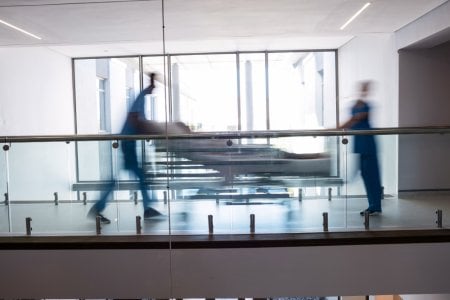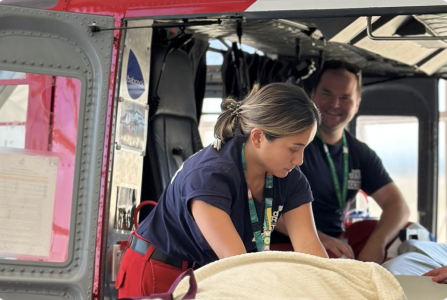Aussie mum dies after enduring excruciating pain while waiting for an ambulance
By
Seia Ibanez
- Replies 19
In a heart-wrenching incident that has left a family in despair and a nation in shock, a beloved Australian mum lost her life after enduring hours of excruciating pain, waiting for an ambulance that tragically never arrived.
This incident has sparked a nationwide debate on the state of emergency services and the urgent need for reform.
Betty Dobson, a cherished mother and wife, was at her home in Adelaide, a mere 2km from an ambulance station when she began to experience unbearable pain in February 2023.
She had been battling pancreatic cancer since her diagnosis in November of the previous year, undergoing chemotherapy and radiation treatments.

In the face of her escalating pain, her husband made the critical call to the ambulance service, expecting prompt assistance.
However, after a distressing two-hour wait with no sign of an ambulance, he was left with no choice but to take matters into his own hands.
In an interview with The Advertiser, Mr Dobson recounted the harrowing ordeal, 'I recalled them, and they said…not only was there not (an ambulance) on the way, but she couldn't tell me when there would be one available.'
The desperate husband had to endure the agonising task of moving his wife of 50 years into a small car and driving her to Noarlunga Hospital himself.
Upon their arrival, the hospital staff, who had been anticipating Ms Dobson's arrival via ambulance, immediately performed scans and administered pain medication.
However, the surgeon delivered the devastating news that surgery was unlikely to save her and recommended palliative care.
Ms Dobson passed away the following day.
Mr Dobson said that the only reason he had called an ambulance was so his wife could be provided with immediate relief for her ‘excruciating pain’.
He and his daughter Julie have called for changes to the ambulance service, which would see callers give an estimated wait time.
'She still would have died, but the night before, she wouldn't have been in pain as much had there been a different outcome,' Julie said.
A South Australia Ambulance Service (SAAS) spokesperson said, 'This case was triaged as a Priority 3, and the call was cancelled 22 minutes later at the caller's request, as we were unable to give a definite timeframe.’
'Callbacks are standard practice and have been in place for many years. Every effort is made to keep patients informed where delays are occurring. This is sometimes achieved when patients call us back, as in this case.’
'It is not uncommon for patients to consider self-transport after discussions with our Emergency Operations Centre staff. Where patients raise a concern about their call or care, every case is reviewed.'
This incident highlighted the state of emergency services in Australia, particularly in South Australia.
The state's ambulance service has been under scrutiny for handling emergency calls, with thousands of patients being transported in taxis instead of ambulances due to a chronic health service crisis.
Ramping, a situation where ambulances cannot transfer patients directly to hospital emergency departments due to capacity issues, has been a significant problem.
Between January 2021 and April 2022, over 4,000 patients were transported in taxis due to this issue, costing more than $120,000.
SAAS has defended its use of taxis, stating that they are not used to replace ambulances for critical care.
‘Instead, they are on occasion provided to patients who have received clinical assessment from a specialist paramedic and require transportation to access healthcare but do not require an emergency ambulance response,' they said.
'Ambulance dispatch is based on the urgency and severity of the medical situation, prioritised to ensure those with the most urgent needs receive an emergency response first.'
The SAAS has also stated its commitment to improving ambulance wait times and has increased its capacity to respond to emergencies by employing an additional 171 paramedics.
The government has also announced a record investment from Peter Malinauskas in the state's ambulance service, including the addition of 36 new ambulances, 350 paramedics, and 10 new stations across the state.
'We are also opening 150 additional hospital beds this year, with more to come online in 2025, to ensure more capacity in our hospitals and freeing up ambulance resources to respond to community needs,' the spokesperson said.
The Dobson family's tragic experience is not an isolated incident.
In December, a 54-year-old man from Adelaide's northeast died after waiting for over 10 hours for an ambulance.
He had called for help due to severe abdominal pain and vomiting but was initially categorised as a low-priority case.
His condition deteriorated over the course of the wait, and despite eventually being upgraded to a top-priority case, help arrived too late.
 Have you or someone you know experienced similar issues with emergency services? Share your experiences and thoughts in the comments below.
Have you or someone you know experienced similar issues with emergency services? Share your experiences and thoughts in the comments below.
This incident has sparked a nationwide debate on the state of emergency services and the urgent need for reform.
Betty Dobson, a cherished mother and wife, was at her home in Adelaide, a mere 2km from an ambulance station when she began to experience unbearable pain in February 2023.
She had been battling pancreatic cancer since her diagnosis in November of the previous year, undergoing chemotherapy and radiation treatments.

Betty Dobson had been waiting for an ambulance at her home in Adelaide while in pain. Credit: Freepik
In the face of her escalating pain, her husband made the critical call to the ambulance service, expecting prompt assistance.
However, after a distressing two-hour wait with no sign of an ambulance, he was left with no choice but to take matters into his own hands.
In an interview with The Advertiser, Mr Dobson recounted the harrowing ordeal, 'I recalled them, and they said…not only was there not (an ambulance) on the way, but she couldn't tell me when there would be one available.'
The desperate husband had to endure the agonising task of moving his wife of 50 years into a small car and driving her to Noarlunga Hospital himself.
Upon their arrival, the hospital staff, who had been anticipating Ms Dobson's arrival via ambulance, immediately performed scans and administered pain medication.
However, the surgeon delivered the devastating news that surgery was unlikely to save her and recommended palliative care.
Ms Dobson passed away the following day.
Mr Dobson said that the only reason he had called an ambulance was so his wife could be provided with immediate relief for her ‘excruciating pain’.
He and his daughter Julie have called for changes to the ambulance service, which would see callers give an estimated wait time.
'She still would have died, but the night before, she wouldn't have been in pain as much had there been a different outcome,' Julie said.
A South Australia Ambulance Service (SAAS) spokesperson said, 'This case was triaged as a Priority 3, and the call was cancelled 22 minutes later at the caller's request, as we were unable to give a definite timeframe.’
'Callbacks are standard practice and have been in place for many years. Every effort is made to keep patients informed where delays are occurring. This is sometimes achieved when patients call us back, as in this case.’
'It is not uncommon for patients to consider self-transport after discussions with our Emergency Operations Centre staff. Where patients raise a concern about their call or care, every case is reviewed.'
This incident highlighted the state of emergency services in Australia, particularly in South Australia.
The state's ambulance service has been under scrutiny for handling emergency calls, with thousands of patients being transported in taxis instead of ambulances due to a chronic health service crisis.
Ramping, a situation where ambulances cannot transfer patients directly to hospital emergency departments due to capacity issues, has been a significant problem.
Between January 2021 and April 2022, over 4,000 patients were transported in taxis due to this issue, costing more than $120,000.
SAAS has defended its use of taxis, stating that they are not used to replace ambulances for critical care.
‘Instead, they are on occasion provided to patients who have received clinical assessment from a specialist paramedic and require transportation to access healthcare but do not require an emergency ambulance response,' they said.
'Ambulance dispatch is based on the urgency and severity of the medical situation, prioritised to ensure those with the most urgent needs receive an emergency response first.'
The SAAS has also stated its commitment to improving ambulance wait times and has increased its capacity to respond to emergencies by employing an additional 171 paramedics.
The government has also announced a record investment from Peter Malinauskas in the state's ambulance service, including the addition of 36 new ambulances, 350 paramedics, and 10 new stations across the state.
'We are also opening 150 additional hospital beds this year, with more to come online in 2025, to ensure more capacity in our hospitals and freeing up ambulance resources to respond to community needs,' the spokesperson said.
The Dobson family's tragic experience is not an isolated incident.
In December, a 54-year-old man from Adelaide's northeast died after waiting for over 10 hours for an ambulance.
He had called for help due to severe abdominal pain and vomiting but was initially categorised as a low-priority case.
His condition deteriorated over the course of the wait, and despite eventually being upgraded to a top-priority case, help arrived too late.
Key Takeaways
- A South Australian woman died after a prolonged wait for an ambulance that failed to arrive in time, despite living only 2km from the station.
- The woman had been dealing with pancreatic cancer and was in severe pain, prompting her husband to drive her to the hospital himself after a two-hour wait.
- The family is now calling for changes to the ambulance service, such as providing estimated wait times to callers.
- There are wider issues with the state's ambulance service, including a chronic health service crisis, hospital ramping, and using taxis to transport some non-urgent patients.








